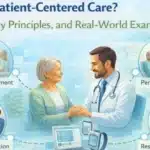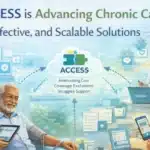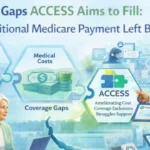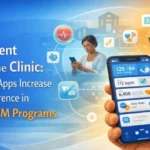Chronic, Principal, and Transitional Care Management Software: Which Is Right for You?

Want to boost patient engagement and health outcomes at your healthcare practice? Confused about which remote care program or software should you implement? With chronic illnesses rising at a record pace, managing patients and ensuring smooth transition of care has become a significant challenge.
To address these concerns regarding care delivery, healthcare providers are highly relying on advanced care solutions, with Chronic Care Management (CCM), Principal Care Management (PCM), and Transitional Care Management (TCM) being the most popular ones. But, how to know which of these would help your patients the most or which of them will deliver optimal health results.
In this blog, we have briefly explained the key differences between CCM, PCM, and TCM to help healthcare providers determine the best fit for their practice.
Table of Contents
ToggleChronic Care Management (CCM)
CCM services are provided to Medicare beneficiaries having two or more chronic health conditions, such as diabetes, hypertension, asthma, or COPD, and are expected to last at least a year or until the death of the patient.
It benefits patients by helping them understand their condition and providing careful monitoring so that medication, treatment plans, and other therapies can be modified with timely interventions. This service must be provided by a physician or a qualified health care provider (QHCP) and requires a minimum of 20 minutes per month by clinical staff or 30 minutes by a physician or QHCP.
Chronic care management software automates routine tasks and enables clinicians to focus on delivering quality care. Key features of CCM software include:
- Automated appointment scheduling and reminders
- Centralized patient records and health information exchange
- Seamless communication between providers and patients
- Coordination of referrals and follow-up appointments
- Real-time tracking of vital signs, medication adherence, and other health metrics
- Identification of potential health risks and early intervention
- Simplified billing and reimbursement processes
- Integration with billing systems to ensure accurate claims
Principal Care Management (PCM)
PCM is for patients who require continuous clinical monitoring and care coordination. Unlike CCM, PCM requires only one complex chronic illness in patients, which may be uncontrolled diabetes, advanced hypertension, or severe asthma, which may result in frequent hospital readmissions. It is delivered by a physician or QHCP and requires clinical staff, physicians, or QHCPs to spend at least 30 minutes every month.
Principal care management software is an advanced solution and offers a comprehensive approach to care coordination, including:
- Development of personalized care plans and goals
- Identification of potential health risks and preventive strategies
- Seamless coordination of care transitions for different settings
- Effective communication with providers and caregivers
- Minimization of care gaps and sudden emergencies
- Integration of mental health into the care plan
- Use of data analytics to identify high-risk patients
- Proactive intervention strategies to prevent adverse events
Transitional Care Management (TCM)
Transitional Care Management provides assistance to patients during the post-discharge period to support transition from a hospital or healthcare facility to their homes or community settings. It provides support to patients during the transition period to reduce the likelihood of hospital readmissions and health complications, along with improving overall health outcomes.
TCM services can be provided by qualified healthcare professionals, including physicians, non-physician practitioners (NPPs) like certified nurse midwives (CNMs), clinical nurse specialists (CNSs), nurse practitioners (NPs), and physician assistants.
Transitional care management software focuses on coordinating care transitions and its key features include:
- Identification of high-risk patients who need support during the transition
- Assessment of patient’s needs and potential risks
- Creation of personalized care plans outlining post-discharge care needs
- Coordination of medications, referrals, and follow-up appointments
- Effective communication between healthcare providers, patients, and caregivers
- Early identification and intervention for potential complications
Key Differences Between CCM, PCM, and TCM
Though CCM, PCM, and TCM sound similar, they differ in many regards. All chronic illnesses are eligible for PCM, CCM TCM. Between CCM and PCM, the difference is the number of chronic conditions they cover with CCM covering multiple conditions, whereas PCM covers one chronic condition. TCM is for successfully transitioning from a hospital to home or care settings within 30 days of discharge. When it comes to the differences among the three, we have crafted some points that highlight the variations.
- Chronic Care Management (CCM)
-
- Patients with multiple chronic conditions
- Coordination between providers and specialists
- Remote monitoring of vital signs and other health metrics
- Focus on Social Determinants of Health (SDOH)
- Data analytics and reporting
- Principal Care Management (PCM)
-
- Patients with complex or high-risk conditions
- Comprehensive care coordination, including transitions of care
- More intensive remote monitoring and telehealth services
- Strong focus on addressing Social Determinants of Health (SDOH)
- Advanced analytics and predictive modeling
- Transitional Care Management (TCM)
-
- Patients transitioning between care settings
- Focused on care transitions and post-discharge follow-up
- Limited remote monitoring, primarily focused on post-discharge follow-up
- May consider Social Determinants of Health (SDOH) that impact post-discharge care
- Data analytics to identify high-risk patients and measure transition outcomes
CCM vs PCM vs TCM
| Feature / Program | Chronic Care Management (CCM) | Principal Care Management (PCM) | Transitional Care Management (TCM) |
|---|---|---|---|
| Purpose | Ongoing care for patients with two or more chronic conditions | Focused care for one high-risk or complex condition | Coordinated care during 30 days post-discharge |
| Typical Patients | Seniors or long-term chronic patients | Patients needing specialty-led management for one main condition | Recently discharged patients at risk of readmission |
| CPT Codes | 99490, 99439, 99487, 99489 | 99424, 99425, 99426, 99427 | 99495, 99496 |
| Key Activities | Care plan creation, monthly follow-up, medication management | Intensive single-condition management, patient education | Follow-up calls, medication reconciliation, appointment scheduling |
| Care Duration | Ongoing, month-to-month | Ongoing, until condition stabilizes or changes | Limited to 30 days after discharge |
| Billing Frequency | Monthly | Monthly | Once per transition episode |
| Medicare Eligibility | 2+ chronic conditions expected to last ≥12 months | One complex condition expected to last ≥3 months | Discharge from hospital, SNF, or rehab facility |
| Common Benefits | Improves long-term health outcomes | Prevents worsening of key condition | Reduces readmissions, improves recovery |
| Best For | Primary care practices | Specialists (e.g., cardiology, oncology) | Primary care & hospitals with high readmission rates |
| Software Role | Tracks patient data, care plans, and compliance | Supports focused interventions, condition tracking | Coordinates follow-ups, reminders, and billing |
Which is Right for Your Practice?
Before choosing the right software for your practice and patients, it’s important to consider factors such as patients’ risk classification, care team size, reimbursement, and infrastructure at your practice.
Patients with multiple chronic conditions qualify for CCM while PCM very specifically caters to patients with a single but more acute chronic condition that requires extensive care.
TCM, on the other hand, is for transitioning patients from an in-patient hospital setting to their homes or community settings.
Prior to choosing the appropriate remote care model that is suitable for the patient, it’s important to understand your practice’s infrastructure and determine whether the software you are choosing can get in sync with your existing system.
Key Takeaways
- CCM—Manages two or more chronic conditions with continuous, coordinated care.
- PCM —focuses on one high-risk condition
- TCM—Supports patients for 30 days post-discharge to prevent readmissions.
- Right software—Streamlines workflows, integrates with EHRs, and ensures CMS compliance.
- Combined programs—Boost Medicare reimbursements and patient satisfaction.
- HealthArc—Unifies CCM, PCM, and TCM in one platform for efficiency and better outcomes.
Frequently Asked Questions (FAQs)
CCM Software Solutions assist practitioners with managing patients with two or more chronic conditions by providing plan creation and tracking, secure messaging, and documentation compliant with Medicare requirements.
PCM is targeted at one high-risk or complex issue, whereas CCM is multi-faceted, revolving around several chronic conditions. It is most useful when the patient’s primary issue is deeply managed by a particular specialty.
TCM Software is specifically designed to assist patients in the homecoming processes from the hospital or any other healthcare facility while ensuring that the patients follow up with the necessary healthcare professionals within 30 days to prevent readmission and aid in their recovery.
The services can be billed by physicians, nurse practitioners, physician assistants, and in certain instances, clinical nurse specialists, provided they follow the guidelines set by the CMS.
Software solutions streamline the processes of confirming proper billing, ensuring compliance for documentation, patient notifications, and coordinating care in real-time.
Absolutely. Integrated solutions such as HealthArc provide consolidated dashboards that manage all programs, thus reducing workflow disruption.
CCM: 99490, 99439, 99487, 99489
PCM: 99424, 99425, 99426, 99427
TCM: 99495, 99496
They enhance adherence to care plans, lower hospital admissions, and allow for proactive management for patients considered high-risk.
Conclusion
Investing in a remote healthcare program or software is the need of the hour, especially if you are focused on improving patient engagement and outcomes. By understanding the role CCM, PCM, and TCM play in patient well-being, you can make the right choice of which one to invest in.
HealthArc’s all-in-one advanced care management software supports a wide range of remote care programs to help improve patient outcomes, enhance care coordination, and optimize your practice’s efficiency. Schedule a demo today to find out how our platform works.
Most Recent Blogs
Categories
Related Blog
- December 22, 2025 | Read Time: 23 mins
CMS ACCESS is Advancing Chronic Care through Effective, and Scalable Solutions
Introduction: Why Chronic Care Needs a New Model Chronic disease management has...
Learn More- December 20, 2025 | Read Time: 10 mins
Coverage Gaps ACCESS Aims to Fill: What Traditional Medicare Payment Left Behind
Medicare paid for visits but not for care. For a long time,...
Learn More- February 21, 2025 | Read Time: 6 mins
RPM’s Role in Identifying Early Symptoms of Chronic Conditions for Prevention
Remote patient monitoring (RPM) systems allow for the continuous tracking of essential...
Learn More


